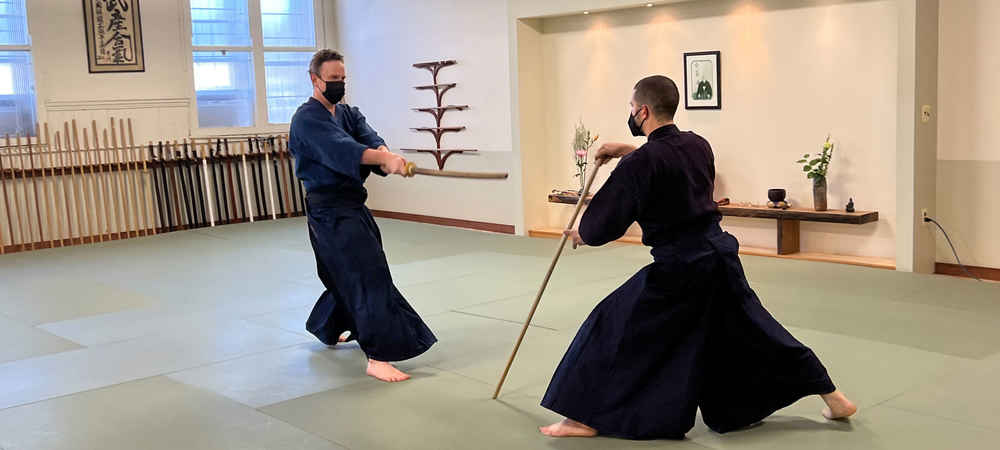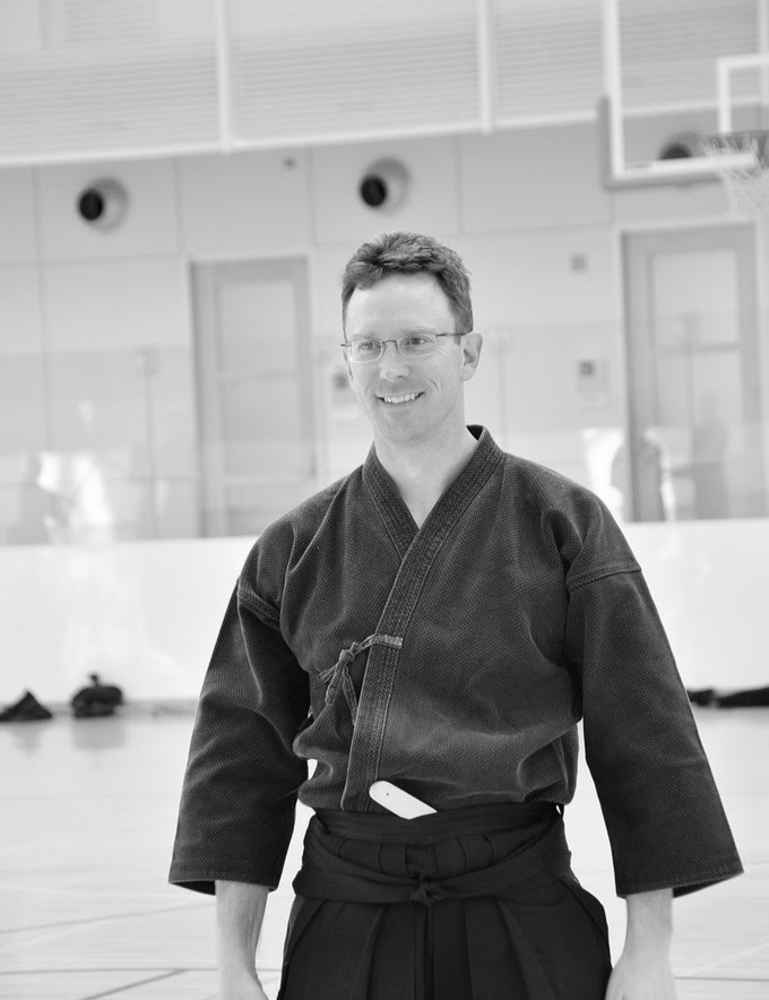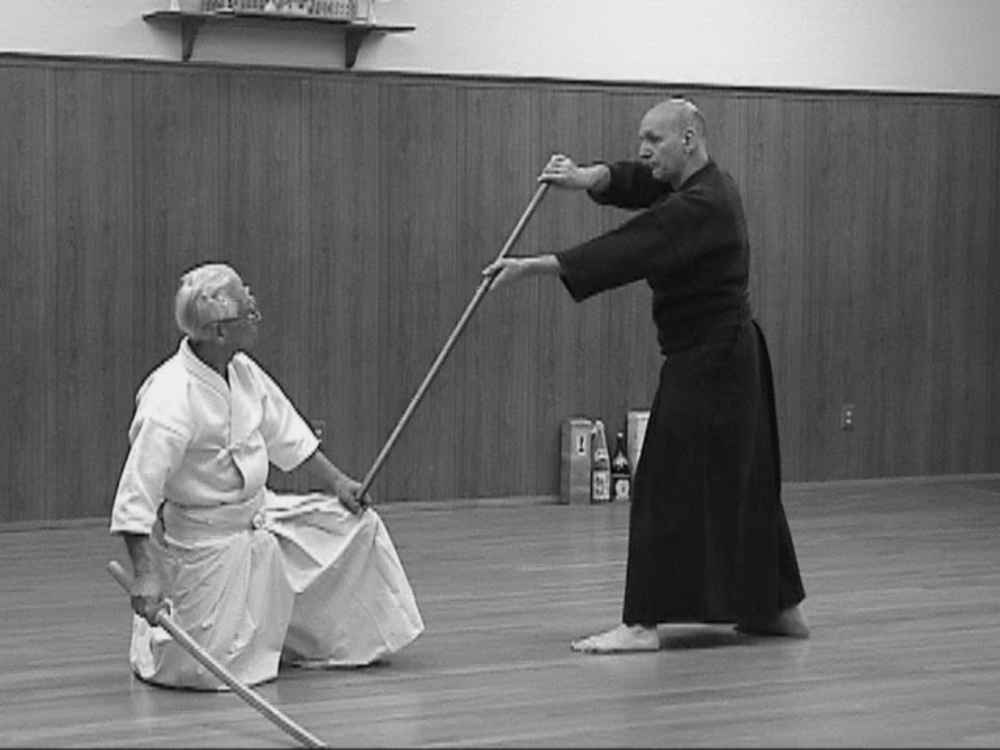What is the practice like?
In Jo, practice is paired forms (kata), leaning to use a jo against a swordsman. This is different from some other arts where the primary practice is solo. This is an important distinction as paired weapons practice brings a level of uncertainty to training.
I see people using a jo in aikido class. Is this the same thing?
Although both aikido and SMR are Japanese arts, they have a very different history. The jo in akido (sometimes called aiki-jo) was developed in the 20th century by the founder of aikido, Morhihei Ueshiba. It was then systemized in various ways by his students. SMR is a much older art with a specific training method, handed down over hundreds of years directly from teacher to student. Training in SMR will enhance your understanding of martial movement, training methods, and concepts - all potentially applicable to aikdo (or any martial art). Ultimately, they are and should remain distinct arts. Those who train in both SMR and aiki-jo should be careful not to mix them.
How physically demanding is training?
Training does not involve falling or aikido style ukemi. The emphasis is on power and efficiency though proper technique, rather than through muscle. Everybody trains at their own level and pace, but for those who which to push themselves jo can be demanding both physically and mentally. The best jo practicioners are also very capable athletes.
What costs are there?
We are not a commercial dojo, but there are still costs associated with training. The current costs are:
- Training Fee. Included in dues for Baltimore Aikido members. $50 per month for Jodo only. $15 per class fee is fine to start.
- Yearly membership fee, payable the beginning of the year: $25
- One-time New Member fee, payable the beginning of the year after you first join: $50
What is the art called? You keep changing the name.
The name is Shinto Muso-ryu jo. Sometimes we abbreviate to "jo" or “jodo," and sometimes we abbreviate to SMR.
What is the teaching method?
Unlike some other martial arts - aikido, for example - where everyone does whatever is taught in class, jodo has a curriculum, which means that techniques are taught in a specific order. Everyone proceeds at their own pace, more senior students working with newer ones on what they are learning. It is important that you are aware of where you are in the curriculum. Just observing, or listening to someone else get taught, does not move you through the curriculum.
What about other cool techniques I see people doing, they don’t look so hard?
It is not appropriate to practice techniques you have not been taught. If you are in a situation where your partner doesn’t know where you are and moves into unknown territory, you should say that you haven’t learned that technique yet, and move on to something else. Jo side and sword side are considered separate techniques – if you have learned the Jo side of a technique, it doesn’t mean you have also learned the sword side.
How fast will I progress?
That will vary with the individual, the teacher, and the amount of training you are able to do (both in class and on your own). In the beginning it is natural to want to practice more than the few things you have been shown. Remember, jodo is more about depth than breadth. The most basic technique you have been shown will truly take a lifetime to master. Be patient and you will soon find you have more than you can handle.
How often should I train?
We currently only have two classes a week. You should make the commitment to come every week. Training by yourself outside of class will have a significant impact on your progress, and is encouraged. If you are unable to make training for some reason, especially it is if for more than a week or so, please call, text, or send me an e-mail so I know you haven’t dropped off the face of the earth
Is this stuff secret?
No, not really. Japanese Koryu does have a culture of secrecy, and only people who have permission from the leader of the group you are training with can teach. The leader of our branch of Jo is Philip Relnick-sensei, who lives in Seattle, WA. Diane Skoss-sensei in NJ is our regional leader on the East Coast. Others in the area (including myself) have received permission to teach. We ask that you respect this tradition and do not teach jodo without permission. Even within class, it is generally not appropriate to correct or show others what you know. This is more a matter of quality control than secrecy.
Is there a ranking system?
Yes. We use the traditional ranking system of Shinto Muso Ryu jo, but it won’t be relevant until you’ve been training for a number of years. These are certificates and scrolls awarded afer a number of years of training. Our group has chosen not to create additional rankings for the purpose of giving people shorter term goals.
What is deal with seniority?
Your seniority date is based on the day you first start training. It is relevant when you line up, and when you start training with somebody; the senior person usually takes the sword first.
What is with all the Japanese?
Well, it is a Japanese art. There are lots of ways to approach this, but our approach is to use Japanese terms for our technique names, commands, etc. There are cheat sheets available. Taking a little time to learn these will make you feel more comfortable in training.
What about etiquette?
There are many specific points on how to behave in a dojo, but you will figure out most of them over time. In general take seriously how you behave, as it sets an important tone for the dojo and for training. To quote from Krieger-sensei: “it not easy to learn peace through the study of war.” Being respectful is the essence etiquette.
A few specific points on weapons handling are worth noting:
- In general, weapons should be handled respectfully.
- You should never step over weapons (yours, or anyone else’s).
- You should never use someone else’s weapons without first asking permission.
What do I need in order to start training?
After observing, you are welcome to come to your first few classes without anything special. If you decide to continue, you should invest in proper gear.
- Weapons. You will need a jo (of course), and a bokken (long sword). The jo and bokken should be of appropriate length for Shinto-muso ryu. You should get a tsuba (hand guard) for your bokken. In Baltimore, you can get proper weapons from Kiyota’s at 2326 N. Charles Street. Mr. Kiyota knows the right type. Regarding the tsuba, plastic is fine in the beginning. Don’t let Kiyota-san sell you the water buffalo unless you really feel like spending $50. You will also need a tsuba-dome – the little rubber thing that holds the tsuba in place.
- Obi (belt). Traditional wide obi is best. Other (Judo, Karate, Aikido) types are acceptable as well, especially in the beginning. Black is preferred.
- Uwagi (uniform top). We prefer that traditional blue kendo-type top. White is acceptable as well, especially in the beginning. Pants are optional as we all wear Hakama. No patches or other distinguishing marks.
- Hakama (the skirt). Everyone should wear a Hakama. Aikido type Hakama is fine.
Can I use my Jo/Bokken from Aikido (or some other art)?
Possibly. The Jo/Bokken that we use in Shinto-muso ryu are of a specific length. Even if you are taller, or shorter, the weapons still need to be a specific length. Bring them and check.
What is the deal with “seitei” and “koryu”?
You may hear about this, so it is worth mentioning. When you first start, the curriculum you will learn will be an introductory set of techniques called “seitei-gata.” After a certain point (maybe a year or so), you will switch to the traditional “koryu” curriculum – “koryu” means “old style.” It is at this point that your real training in the ryu will begin.
When will I learn the other weapons?
The kata that specifically train the other weapons (sword, short staff, jutte, etc...) are taught after a solid foundation with the jo has been established, which takes several years.
Looks interesting. What is the process if I want to train?
Pleae do not come to class without first contacting David Pitard. I ask that you come to at least two full classes to observe, even if you are already training aikido. This gives you a chance to see what training is like, and also gives us a chance to meet. When observing, the expectation is you will stay for the whole class, and you will actually be observing – not texting, reading etc. Please schedule ahead so that I know when you are planning to come observe. Contact David Pitard to arrange a time.
If you have any questions which are not covered in the above FAQ, or wish to discuss training, please use the Jodo Form on this page to contact David Pitard.






